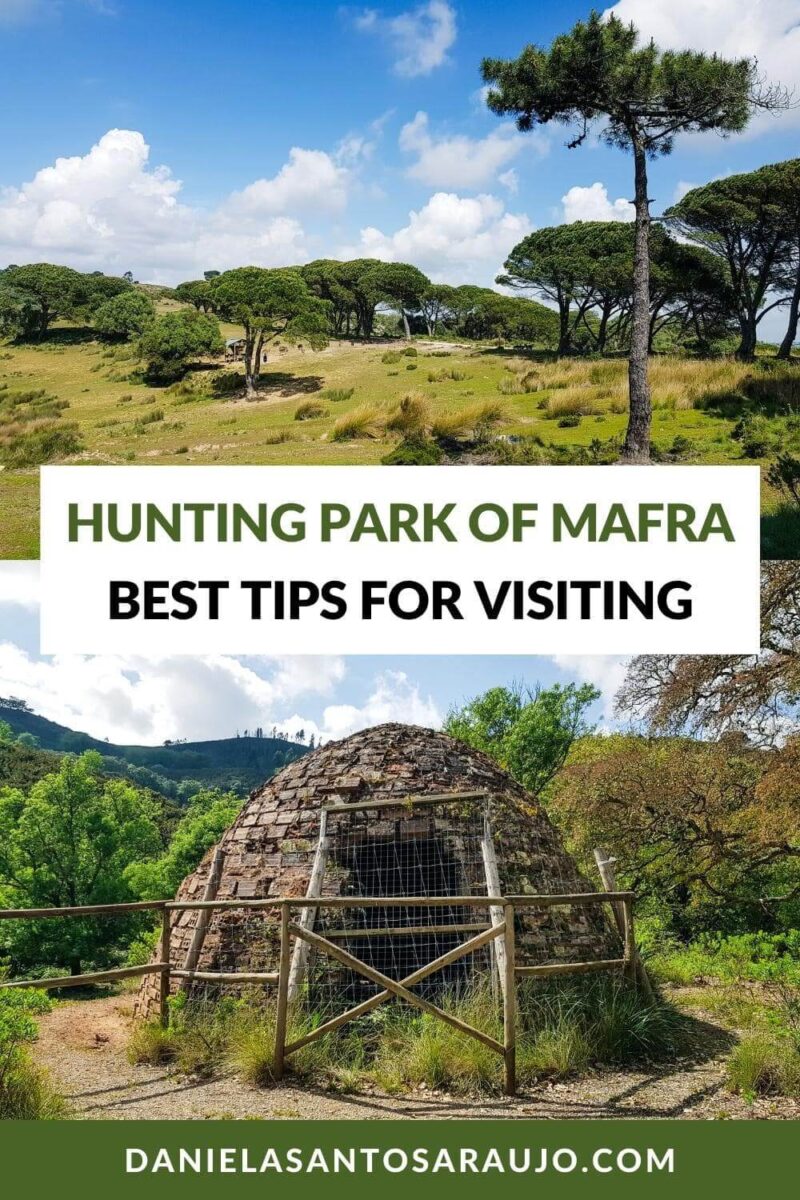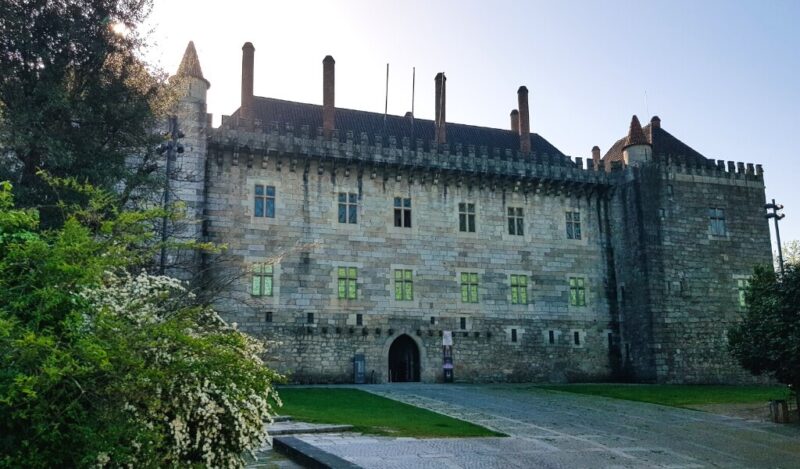The Royal Hunting Park of Mafra (in Portuguese, Real Tapada de Mafra) was founded by King João V in 1747, following the construction of the Palace-Convent of Mafra. Famous for the diversity of wildlife, it’s inhabited by deer, fallow deer, wild boar, foxes, and birds of prey – among other species of fauna and flora!
With an area of almost 1200 hectares, the Royal Hunting Park of Mafra served as a hunting and leisure place for Portuguese royalty, especially during the reigns of Luís I and Carlos I (1861-1908).
In 1910, the site was renamed the National Hunting Park of Mafra (in Portuguese, Tapada Nacional de Mafra) and was used almost exclusively for hunting. Nowadays, it’s focused on ecotourism and adventure tourism, promoting races, hiking and mountain biking tracks, carriage and electric car rides, and much more!
So, do you want to know How To Visit The National Hunting Park Of Mafra In 2024? Keep reading!
This post may contain affiliate links, meaning I earn a small commission if you make a purchase, at no additional cost to you. Please read my disclosure & privacy policy for more information.
No time to read now? Pin it for later!


Brief History of the National Hunting Park of Mafra
Even though the construction work on the Palace-Convent of Mafra began in 1717, King João V only acquired the land to create the Royal Hunting Park of Mafra in 1744. His main objective with this purchase was to ensure the self-sufficiency of the Palace-Convent and provide an outdoor playground for the Royal Family.
The Royal Hunting Park of Mafra was used regularly for walks and hunts, either by King João V and Queen Maria Ana of Austria or by King José I and Queen Mariana Vitória de Bourbon (their successors). Apart from that, this large park guaranteed the water supply for the entire palatial complex (including the Cerco Garden).

In the following reigns, almost all the monarchs showed great interest in the Royal Hunting Park of Mafra. Even so, there were some that stood out: King João VI, King Consort Fernando II (husband of Queen Maria II), King Luís I, and King Carlos I (with Queen Amélia de Orleães).
With the Implantation of the Republic on October 5th, 1910, and the Royal Family in exile, the Royal Hunting Park of Mafra is renamed National Hunting Park of Mafra and becomes one of the favorite hunting reserves of the First Republic (1910-1926) and the Estado Novo (1926-1974).
World Heritage
Did you know that the National Hunting Park of Mafra was part of Portugal’s twelfth set of inscriptions on the UNESCO World Heritage List? This 43rd session of the World Heritage Committee took place in Baku (Azerbaijan), between June 30th and July 10th, 2019.
Only one other Portuguese site was announced in the session: the Sanctuary of Bom Jesus do Monte in Braga.
Nowadays, Portugal is the ninth country in Europe and the eighteenth country in the world with the most UNESCO sites, tied with Czechia and Poland. It has seventeen heritage assets (both cultural and natural) inscribed on the world list of the United Nations Educational, Scientific, and Cultural Organization.
In the meantime, I’ve already had the opportunity to visit fourteen of them:
- Alto Douro Wine Region (2001)
- Convent of Christ in Tomar (1983)
- Cultural Landscape of Sintra (1995) – Chalet of the Countess of Edla, Convent of the Capuchos, Moorish Castle, National Palace of Pena, National Palace of Sintra, Palace of Monserrate, Quinta da Regaleira, Villa Sassetti
- Garrison Border Town of Elvas and its Fortifications (2012)
- Historic Center of Évora (1986)
- Historic Center of Guimarães and Couros Zone (2001, 2023)
- Historic Center of Porto, Luiz I Bridge, and Monastery of Serra do Pilar (1996)
- Monastery of Alcobaça (1989)
- Monastery of Batalha (1983)
- Monastery of the Hieronymites and Tower of Belém in Lisbon (1983)
- Prehistoric Rock Art Sites in the Côa Valley (1998, 2010)
- Royal Building of Mafra – Palace, Basilica, Convent, Cerco Garden, and Hunting Park (Tapada) (2019)
- Sanctuary of Bom Jesus do Monte in Braga (2019)
- University of Coimbra – Alta and Sofia (2012)
How to Get to the National Hunting Park of Mafra
Most tourists who visit the National Hunting Park of Mafra take the opportunity to do so on a day trip from Lisbon. Thus, they can spend the whole day in Mafra and discover the main points of interest in the town (namely the five that make up the Royal Building in Mafra and that are UNESCO World Heritage Sites):
- National Palace of Mafra
- Convent of Mafra
- Basilica of Mafra
- Cerco Garden
- National Hunting Park of Mafra
However, Mafra is also an excellent stop on a road trip through the Lisbon Metropolitan Area region and the Lisbon district! In that case, I suggest you explore other destinations in the vicinity: Sintra (22 km), Torres Vedras (24 km), Loures (25 km), Sobral de Monte Agraço (26 km), Odivelas (31 km), Arruda dos Vinhos (34 km), and Cascais (36 km).


Opening Hours & Ticket Prices
The National Hunting Park of Mafra is open every day from 9 am to 7 pm. Nevertheless, it’s important to mention that the visit is not free, but conditioned by the type of ticket you buy! And each ticket is associated with a very specific experience:
- Blue Pedestrian Track – 5€
- Carriage Ride – 13.5€
- Eco Tour – 10.5€
- Forest Run – 5€
- Green Pedestrian Track – 5€
- MTB Track – 6€
- Red Pedestrian Track – 5€
- Rented Bike – 16.5€
- Eco Passeio – 10.5€
- Yellow Pedestrian Track – 5€
What to See at the National Hunting Park of Mafra
Lime Kiln
Did you know that there are three lime kilns spread across the National Hunting Park of Mafra? These small lime kilns were installed during the construction of the wall that delimits the enclosure – a wall that is 21 km long!

The Lime Kiln (in Portuguese, Forno de Cal) that you see in the photograph is an obligatory stop on any of the four walking tracks (Blue, Green, Red, and Yellow). Deactivated in 1965, it was used for charcoal production in the 19th and 20th centuries, and is still in excellent condition!
Celebredo
The Celebredo is the noblest area of the National Hunting Park of Mafra, where King Carlos I and Queen Amélia de Orleães ordered the installation of several buildings to support their recreational activities in the forest park. This valley has been referenced since the end of the 18th century and consists of several spaces:
- King Carlos’ Hunting Pavilion
- Museum of Coaches and Carriages
- Salabredo’s House and Garden
- Old Stables
King Carlos’ Hunting Pavilion
King Carlos’ Hunting Pavilion (in Portuguese, Pavilhão de Caça do Rei D. Carlos) was rebuilt in 1893, at the request of King Carlos I. And, according to historical records, the original building that preceded it was called the Celebredo Palace (in Portuguese, Palacete do Celebredo). There’s also a fountain that makes up the complex and it dates from 1885.

Adapted with piped and drinking water, King Carlos’ Hunting Pavilion served as a resting place for the Royal Family on hunting days. Interestingly, it was here that lunch was held with animals killed in these hunts!
Museum of Coaches and Carriages
The Museum of Coaches and Carriages of the National Hunting Park of Mafra is a kind of National Coach Museum in miniature. The big difference is that the collection is the result of a donation from Segismundo Saldanha, the former councilor and vice-president of the Lisbon City Council, as well as the former director of the National Hunting Park of Mafra.
In the collection of the Museum of Coaches and Carriages, it’s possible to admire animal-drawn cars from the 19th and 20th centuries, instruments typical of equestrian art (mostly saddles and harnesses), and various types of vehicles: brake, coupé, landau, victoria, etc., in addition to Queen D. Amélia’s personal carriage!
Salabredo’s House and Garden
Salabredo’s House (in Portuguese, Casa do Salabredo) was the former support house for the administrator of the National Hunting Park of Mafra during the Estado Novo. But, at the end of the 20th century, it was transformed into a local accommodation and is now a perfect retreat in the heart of the National Hunting Park of Mafra!

As for the Garden of Salabredo’s House (in Portuguese, Jardim da Casa do Salabredo), it was idealized to the taste of King Consort Fernando II and designed during the reign of Luís I. It’s often called the “Romantic Garden”, because of its 18th-century sculptures and its bucolic atmosphere.
Old Stables
As you would expect, the Old Stables building (in Portuguese, Antigas Cavalariças) is the largest of all in the Celebredo area. Built at the beginning of the 20th century, it maintained its activity as a stables and riding arena until the end of the same century.

Nonetheless, at the beginning of the 21st century, the Old Stables were refurbished to host the most varied corporate events (congresses, conventions, conferences, seminars, etc.) and social events (weddings, baptisms, birthday parties, and other ceremonies).
Trees of Public Interest
In the National Hunting Park of Mafra, there are seven trees classified as Trees of Public Interest (also called “Living Monuments”):
- Ash – native species
- Cork Oak – native species
- Horse Chestnut – introduced species
- Judas Tree – native species
- Mastic – native bush
- Portuguese Oak – native species
- Sycamore – non-native species
Horse Chestnut
The Horse Chestnut (scientific name, Aesculus hippocastanum) is a species native to central and southern Albania, Bulgaria, and northwest Greece. Planted in Portugal as an ornamental species, it’s a robust and large tree, which can reach 25 meters in size!

The Horse Chestnut of the National Hunting Park of Mafra is an example that is over 300 years old and is believed to have been planted by King Luís I. You can find it in the Celebredo area, a few steps from King Carlos’ Hunting Pavilion.
Judas Tree
The Judas Tree (scientific name, Cercis siliquastrum) is a species native to southern Europe and southwest Asia. Also known as the “Judas-Tree”, it’s a relatively small tree, about 10-15 meters tall.

Like the Horse Chestnut, the Judas Tree of the National Hunting Park of Mafra is an example that is over 300 years old. And this deciduous tree with pink flowers can also be found at Celebredo, right in front of Salabredo’s House!
Share this blog post on your social media!
More Posts about Portugal
4 Best Monasteries In Portugal (That You Should Visit This Year)
5 Best Palaces In Sintra (That You Should Visit This Year)
1 Day In Penafiel: The Perfect Penafiel Itinerary
More Posts about Gardens and Parks
National Palace Of Queluz: Best Tips For Visiting In 2024
How To Visit The National Forest Of The Seven Hills In 2024
How To Visit The Horto De Camões Garden In 2024
More Posts about World Heritage
Palace Of The Dukes Of Braganza: Best Tips For Visiting In 2024
World Heritage In Castile And León (2024)
Machado De Castro National Museum: Best Tips For Visiting In 2024
What Photography Gear Do I Use?
- Camera Body: Fujifilm X-T4 Mirrorless
- Camera Lens: Fujinon XF 18-55 mm F2.8-4 R LM OIS
- Tripod: Manfrotto Compact Action
- Small Tripod: Manfrotto PIXI Mini
- Smartphone Adaptor: Manfrotto PIXI Clamp
- Memory Card: SanDisk 128GB Extreme PRO SDXC









